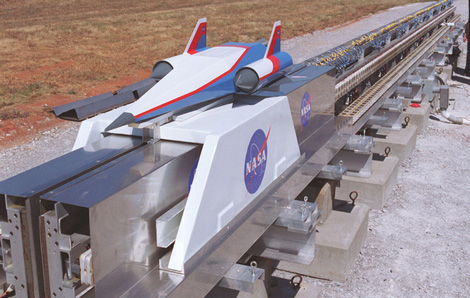Commuter Rail to the Moon

In April, President Obama asked engineers to come up with a less expensive method for launching a spacecraft. So NASA has come up a system that it says would save millions of dollars in propellant and allow more frequent flights – all while improving astronaut safety.
The system consists of a pilot-controlled scramjet (supersonic combustion ramjet) carrying a spacecraft and a two-mile-long rail gun, which would propel the scramjet and spacecraft to 200,000 feet.
In order to fly the spacecraft into orbit, the rail gun is used to accelerate the scramjet and spacecraft down a two-mile track. The rail gun uses a 240,000-horsepower linear motor to convert 180 megawatts into an electromagnetic force, used to propel the crafts instead of an explosion. At the end of the track the pilot would fire a high-speed turbojet that would launch the scramjet into the air. Once flying, the scramjet would hit Mach 4 (four times the speed of sound) and produce tens of thousands of pounds of thrust.
At an altitude of 200,000 feet, the scramjet would be flying at Mach 10 and would need to separate from the spacecraft as there would not be enough air for it to generate thrust. After separating, the scramjet would use its turbojets to fly back to Earth and make a runway landing.
The spacecraft, on the other hand, would fire tail rockets in order to shoot itself into orbit and deliver its cargo. Afterward, it would be able to reenter the atmosphere and glide back to the launch site. The scramjet and spacecraft could be ready for another mission within 24 hours of landing.
Even though development of this system would cost about twice as much as a current space shuttle launch, the ability to fly frequently and with less propellant means each flight would be significantly cheaper than current launches.
The process may seem fantastical, but NASA has developed a scramjet that flew to 200,000 feet at Mach 10 for 12 seconds. That is twice the speed that Boeing’s X-51 scramjet reached, although the Boeing craft sustained its speed for a record 200 seconds.
If the space agency succeeds with its plan, it could orbit a 10,000-pound satellite one day and send a manned ship to the moon the next, all on a fraction of the propellant used by today’s rockets.
Check out a video of the Navy’s latest rail gun, which fired a metal bullet at a world-record setting force of 33 megajoules (powerful enough to launch 33 Smart cars at 100 miles per hour):
Check out this video too, which was the Navy’s previous record, set in 2008:
Image: NASA
Filed under: Aerospace, e-News, Mechanical, Transportation
Tags: Aerospace, Mechanical, Military, NASA, Space








